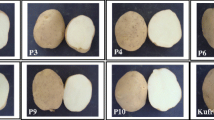Summary
The narrow genetic base of the cultivated potato is a severe constraint for potato breeding. Wild tuber-bearing species constitute an important source of genes for resistance to diseases and pests as well as abiotic factors. Seven interspecific hybrid populations were generated from crosses between diploidTuberosum clones and four wild species:Solanum berthaultii, S. gourlayi, S. tarijense andS. vernei, and evaluated in a field experiment in Burgos (Spain) as a way to broaden the genetic base of the cultivated potato. Good tuberization ability and great variability for yield within the different families were detected. Hybridization with the wild species resulted in high levels of PVY resistance inS. berthaultii andS. vernei hybrids and a large increase of dry matter content in all populations except theS. berthaultii hybrids.
Similar content being viewed by others
References
Bamberg, J.B., M.W. Martin & J.J. Schartner, 1994. Elite Selections of Tuber-bearingSolanum Species Germplasm. Inter-Regional Potato Introduction Station, NRSP-6, Sturgeon Bay, Wisconsin, USA, 52 pp.
Carputo, D., M. Speggiorin, P. Garrefa, A. Raio & L.M. Monti, 1996. Screening for resistance to tuber soft rot and blackleg in diploidSolanum species andS. tuberosum haploids.Journal of Genetics and Breeding 50: 221–226.
Carputo, D., T. Cardi, M. Speggiorin, A. Zoina & L. Frusciante, 1997. Resistance to blackleg and tuber soft rot in sexual and somatic interespecific hybrids with different genetic background.American Potato Journal 74: 161–172.
Clark, M.F. & A.N. Adams, 1977. Characteristics of the microplate method of Enzyme-linked Immunosorbent Assay for the detection of plant viruses.Journal of General Virology 34: 475–483.
De Jong, H. & G.C.C. Tai, 1991. Evaluation of potato hybrids obtained from tetraploiddiploid crosses. I. Parent-offspring relationships.Plant Breeding 107: 177–182.
Gerstner, G., M. Müller, K.-H. Engel, L. Hepting & A. Schwarfischer, 2002. Glycoalkaloid content in dihaploid and tetraploid breeding lines produced by conventional methods, protoplast fusion and genetic engineering. Abstracts of the 15Th Triennial Conference of the EAPR, Hamburg, Germany, 2002, pp. 90.
Hanneman, R.E. & J.B. Bamberg, 1986. Inventory of tuber-bearingSolanum species.USDA Bulletin 533.
Hawkes, J.G., 1994. Origins of cultivated potatoes and species relationship. In: J.E. Bradshaw & G.R. Mackay (Ed.), Potato Genetics. CAB International, Wallingford, UK, pp. 3–42.
Hermunstad, J.A. & S.J. Peloquin, 1985a. Male fertility and 2n pollen production in haploidwild species hybrids.American Potato Journal 62: 479–487.
Hermunstad, J.A. & S.J. Peloquin, 1985b. Germplasm enhancement with potato haploids.The Journal of Heredity 76: 463–467.
Hermunstad, J.A. & S.J. Peloquin, 1986. Tuber yield and tuber traits of haploid-wild species F1 hybrids.Potato Research 29: 289–297.
Hermunstad, J.A. & S.J. Peloquin, 1987. Breeding at the 2x level and sexual polyploidization. In: G.J. Jellis & D.E. Richardson (Ed.), The production of new potato varieties: Technological advantages. Cambridge University Press, Cambridge, pp. 197–210.
Hoekstra, R., 1995. Evaluation data of German-Ducth potato collection. Centre for Genetic Resources The Netherlands (CGN) and Centre for Plant Breeding and Reproduction Research (CPRO-DLO), Wageningen, The Netherlands, 38 pp.
Hutten, R.C.B., 1994. Basic aspects of potato breeding via the diploid level. PhD Thesis, Wageningen University, The Netherlands, 92 pp.
Jansky, S.H., G.L. Yerk & S.J. Peloquin, 1990. The use of potato haploids to put 2x wild species germplasm into a usable form.Plant Breeding 104: 290–294.
Johnston, S.A., T.P.M. den Nijs, S.J. Peloquin & H.R. Hanneman Jr, 1980. The significance of genetic balance to endosperm development in interspecific crosses.Theoretical and Applied Genetics 57: 5–9.
Leue, E.F., 1980. Selection for 2n gametes and tuberization inS. chacoense.American Potato Journal 57: 189–195.
Leue, E.F., 1983. The use of haploids, 2n gametes, and the topiary mutant in the adaptation of wildSolanum germplasm and its incorporation into Tuberosum. PhD Thesis, Winsconsin University, USA, 189 pp.
McLean, J.G. & F.J. Stevenson, 1952. Methods of obtaining seed on Russet Burbank and similar flowering varieties of potatoes.American Potato Journal 35: 701–707.
Oltmans, S.M. & R. Novy, 2002. Identification of potato (Solanum tuberosum L.) haploid x wild species hybrids with the capacity to cold-chip.American Journal of Potato Research 79: 263–268.
Pavek, J.J. & D.L. Corsini, 2001. Utilization of potato genetic resources in variety development.American Journal of Potato Research 78: 433–441.
Peloquin, S.J. & R.W. Hougas, 1959. Decapitation and genetic markers as related to haploidy inSolanum tuberosum.European Potato Journal 2: 176–183.
Raman, K.V., A.M. Golmirzalie, M. Palacios & J. Tenorio, 1994. Inheritance to insects and mites. In: J.E. Bradshaw & G.R. Mackay (Ed.), Potato Genetics. CAB International, Wallingford, UK, pp. 447–466.
Santini, M., E.L. Camadro, O.N. Marcellân & L.E. Erazzü, 2000. Agronomic characterization of diploid hybrid families derived from crosses between haploids of the common potato and three wild Argentinean tuber-bearing species.American Journal of Potato Research 77: 211–218.
Schroeder, S.H. & S.J. Peloquin, 1983. Parental effects for yield and tuber appearance on 4x families from 4x–2x crosses.American Potato Journal 60: 819.
Spooner, D.M. & R.J. Hijmans, 2001. Potato systematics and germplasm collecting, 1989–2000.American Journal of Potato Research 78: 237–268.
Storey, R.M.J. & H.V. Davies, 1992. Tuber quality. In: P.M. Harris (Ed.), The potato crop. Chapman and Hall, London, pp. 507–569.
Tucci, M., D. Carputo, G. Bile & F. Frusciante, 1996. Male fertility and freezing tolerance of hybrids involvingSolanum tuberosum haploids and diploidSolanum species.Potato Research39: 345–353.
Uhrig, H. & G. Wenzel, 1981.Solanum gourlayi Hawkes as a source of resistance against the white potato cyst nematodeGlobodera pallida Stone.Zeitschrift für Pflanzenzüchtung 86: 148–157.
Von Scheele, C, G. Svensson & A. Henostroza, 1936. Die Bestimmung des Stärkegehalts und der Trockensubstanz der Kartoffel mit Hilfe des spezifischen Gewichts.Landwirtsch. Vers. Sta. 127: 67–96.
Yerk, G.L. & S.J. Peloquin, 1989. Comparison of 2n and non-2n pollen-producing haploids x wild species hybrids in potato.Journal of Heredity 80: 468–471.
Author information
Authors and Affiliations
Corresponding author
Rights and permissions
About this article
Cite this article
Ortega, F., Carrasco, A. Germplasm enhancement with wild tuber-bearing species: introgression of PVY resistance and high dry matter content fromSolanum berthaultii, S. gourlayi, S. tarijense andS. vernei . Potato Res. 48, 97–104 (2005). https://doi.org/10.1007/BF02733685
Accepted:
Issue Date:
DOI: https://doi.org/10.1007/BF02733685




